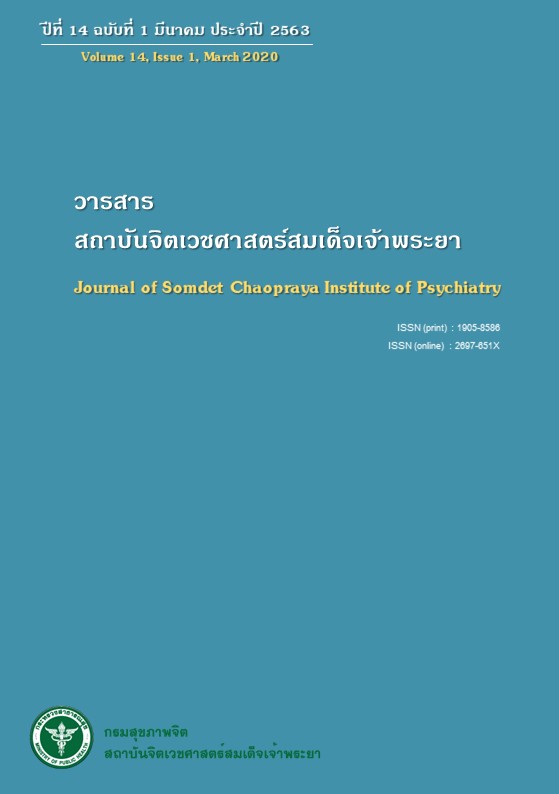การพัฒนาต้นแบบและผลของโปรแกรมกลุ่มจิตบำบัดที่เน้นการแสดงออกต่อพฤติกรรมก้าวร้าวของผู้ป่วยโรคจิตเภท
คำสำคัญ:
กลุ่มจิตบำบัด, การบำบัดที่เน้นการแสดงออก, พฤติกรรมก้าวร้าว, โรคจิตเภทบทคัดย่อ
วัตถุประสงค์ : เพื่อพัฒนาต้นแบบและทดสอบผลของโปรแกรมกลุ่มจิตบำบัดที่เน้นการแสดงออก สำหรับผู้ป่วยโรคจิตเภทที่มีพฤติกรรมก้าวร้าว
วัสดุและวิธีการ : ใช้กระบวนการวิจัยและพัฒนา ตามมาตรฐานการวิจัยและพัฒนาเทคโนโลยีสุขภาพจิต ทำการทดสอบและปรับปรุงครั้งที่ 1 กับผู้ป่วยในโรคจิตเภทจำนวน 10 คน โดยมุ่งเน้นปรับโปรแกรมให้เหมาะสมกับผู้ป่วยในและใช้งานง่าย จากนั้นนำมาทดลองใช้กับผู้ป่วยในโรคจิตเภท จำนวน 18 คน แบ่งเป็นกลุ่มทดลองและกลุ่มควบคุม สุ่มโดยการจับคู่ระดับอาการทางจิต คะแนนพฤติกรรมก้าวร้าว อายุและเพศที่ใกล้เคียงกัน รวบรวมข้อมูลด้วยแบบประเมินพฤติกรรมก้าวร้าว โดยประเมินก่อนและหลังการบำบัด วิเคราะห์โดยใช้สถิติพรรณนาและทดสอบค่าที
ผล : โปรแกรมกลุ่มจิตบำบัดที่เนันการแสดงออกสำหรับผู้ป่วยโรคจิตเภทที่มีพฤติกรรมก้าวร้าว ที่พัฒนาขึ้นมีความตรงตามเนื้อหา และสอดคล้องกัน ระหว่างกิจกรรมกลุ่มและวัตถุประสงค์ โปรแกรมประกอบด้วยการดำเนินกลุ่ม 10 ครั้ง ครั้งละ 90 นาที สัปดาห์ละ 3 ครั้งติดต่อกัน 4 สัปดาห์ ผลการศึกษา พบว่าในกลุ่มทดลองค่าเฉลี่ยคะแนนพฤติกรรมก้าวร้าว ระยะหลังการทดลอง (ค่าเฉลี่ยเท่ากับ 0.9 ± 1.4) ลดลงจากคะแนนเฉลี่ยพฤติกรรมก้าวร้าว ระยะก่อนการทดลอง (ค่าเฉลี่ยเท่ากับ 9.8 ± 1.0) อย่างมีนัยสำคัญทางสถิติที่ระดับ 0.05 และเมื่อเปรียบเทียบกับกลุ่มควบคุมที่ได้รับการรักษาตามปกติ พบว่า ค่าเฉลี่ยคะแนนพฤติกรรมก้าวร้าว ระยะหลังการทดลองต่ำกว่า กลุ่มควบคุม (ค่าเฉลี่ยเท่ากับ 8.5 ± 1.2) อย่างมีนัยสำคัญทางสถิติที่ระดับ 0.05
สรุป : ต้นแบบโปรแกรมกลุ่มจิตบำบัดที่เน้นการแสดงออก สำหรับผู้ป่วยโรคจิตเภทที่มีพฤติกรรมก้าวร้าวเหมาะสำหรับใช้ในการป้องกัน และลดพฤติกรรมก้าวร้าวของผู้ป่วยโรคจิตเภทได้ โปรแกรมนี้สามารถเป็นการเพิ่มทางเลือกในการบำบัดรักษาผู้ป่วยโรคจิตเภทที่มีพฤติกรรมก้าวร้าว ร่วมกับการรักษาตามมาตรฐานต่อไป
เอกสารอ้างอิง
Jansman-Hart E, Seto M, Crocker A, Nicholls T, Côté G. International trends in demand for forensic mental health services. Int J Forensic Ment Health 2011; 10: 326-36.
Charlson FJ, Ferrari AJ, Santomauro DF, Diminic S, Stockings E, Scott JG, et al. Global epidemiology and burden of schizophrenia: findings from the global burden of disease study 2016. Schizophr Bull 2018; 44(6): 1195-203.
Witt K, van Dorn R, Fazel S. Risk factors for violence in Psychosis: systematic review and meta-regression analysis of 110 Studies. PLoS One 2013; 8(2): e55942.
Caqueo-Urízar A, Fond G, Urzúa A, Boyer L, Williams DR. Violent behavior and aggression in schizophrenia: prevalence and risk factors. A multicentric study from three Latin-America countries. Schizophr Res. 2016; 178(1-3): 23-8.
Zhou JS, Zhong BL, Xiang YT, Chen Q, Cao XL, Correll CU, et al. Prevalence of aggression in hospitalized patients with schizophrenia in China: A meta-analysis. Asia-Pac Psychiatry Off J Pac Rim Coll Psychiatr 2016; 8(1): 60-9.
เวนิช บุราชรินทร์, เพ็ญพักตร์ อุทิศ. ปัจจัยคัดสรรที่มีความสัมพันธ์กับพฤติกรรมรุนแรงของผู้ป่วยจิตเภทในชุมชน. วารสารการพยาบาลจิตเวชและสุขภาพจิต 2554; 25(3): 24-37.
Namsoot J, Nimnuan C. Depression and violent behavior of schizophrenic patients and forensic schizophrenic patients at Galya Rajanagarindra Institute. Chula Med J 2016; 60(6): 641-53.
Han D, Park D, Na C, Kee B, Lee Y. Association of aggressive behavior in Korean male schizophrenic patients with polymorphisms in the serotonin transporter promoter and catecholamine-O-methyltransferase genes. Psychiatry Res 2004; 129: 29-37.
Lewis DO. Adult antisocial behavior, criminality, and violence. In: Sadock BJ, Sadock VA, Ruiz P editor(s). Kaplan & Sadock’s Comprehensive Textbook of Psychiatry. 9th ed. Philadelphia (PA): Wolters Kluwer/LippincottWilliams & Wilkins: 2009.
National Institute for Health and Care Excellence. Violence and aggression: short-term management in mental health, health and community settings. Natl Inst Health Care Excel. NICE guideline [NG10]: 2015.
Fazel S. Schizophrenia, substance abuse, and violent Crime. JAMA 2009; 301(19): 2016-39.
Witt K, van Dorn R, Fazel S. Risk factors for violence in psychosis: systematic review and meta-regression analysis of 110 studies. PLoS One 2013; 8(2): e55942.
Fazel S, Gulati G, Linsell L, Geddes JR, Grann M. Schizophrenia and violence: systematic review and meta-analysis. PLoS Med 2009; 6(8): e1000120.
Tolulope O, Virk I, Ishola A, Akerele E. Aggression rate in acute inpatient psychiatric units: impact of substance abuse and psychosis. MOJ Addict Med Ther 2017; 3(1): 15-7.
Nawka A, Kalisova L, Raboch J, Giacco D, Cihal L, Onchev G, et al. Gender differences in coerced patients with schizophrenia. BMC Psychiatry 2013; 13(1): 257.
Lejoyeux M, Nivoli F, Basquin A, Petit A, Chalvin F, Embouazza H. A n investigation of factors increasing the risk of aggressive behavior among schizophrenic inpatients. Front Psychiatr 2013; 4: 97.
Malchiodi CA. Handbook of art therapy. 2nd ed. New York: Guilford Press; 2012.
Malchiodi CA. Expressive therapies. New York: Guilford Press; 2005.
Hakvoort L, Bogaerts S, Thaut MH, Spreen M. Influence of music therapy on coping skills and anger management in forensic psychiatric patients: an exploratory study. Int J Offender Ther Comp Criminol. 2015; 59(8): 810-36.
Hackett SS, Aafjes-van Doorn K. Psychodynamic art psychotherapy for the treatment of aggression in an individual with antisocial personality disorder in a secure forensic hospital: a single-case design study. Psychotherapy 2019; 56(2): 297-308.
ผ่องพรรณ ภะโว. การศึกษาการใช้การผ่อนคลายกล้ามเนื้อร่วมกับการใช้ดนตรีต่อพฤติกรรมก้าวร้าวในผู้ป่วยจิตเภท โรงพยาบาลจิตเวชสระแก้วราชนครินทร์ [วิทยานิพนธ์มหาบัณฑิต]. กรุงเทพฯ: บัณฑิตวิทยาลัย จุฬาลงกรณ์มหาวิทยาลัย; 2549.
Yudofsky SC, Silver JM, Jackson W, Endicott J, Williams D. The Overt Aggression Scale for the objective rating of verbal and physical aggression. Am J Psychiatry 1986; 143(1): 35-9.
Prout TA, Wadkins MJ. Essential interviewing and counseling skills: an integrated approach to practice. New York, NY: Springer Publishing Company; 2014.
Choi AN, Lee MS, Lee JS. Group music intervention reduces aggression and improves self-esteem in children with highly aggressive behavior: a pilot controlled trial. Evid Based Complement Alternat Med 2010; 7(2): 213-7.
Estrella K. Expressive therapy: an integrated arts approach. In Malchiodi CA, editor. Expressive therapies. New York: Guilford Press; 2005: 183-209.
Subedar ST. Social isolation, schizophrenia, and the group experience a theoretical exploration drama therapy [Master degree]. Canada: Concordia University: 2018.
Ibrahim SR, Ahmed FM, Effect of the nursing practice of creative art therapy on psychiatric symptoms among schizophrenic patients. Am J Nurs Res 2019; 7(1): 14-23.
Swanson JW, Swartz MS, Van Dorn RA, Elbogen EB, Wagner HR, Rosenheck RA, et al. A national study of violent behavior in persons with schizophrenia. Arch Gen Psychiatr 2006; 63(5): 490-9.
Ulrich RS, Bogren L, Gardiner SK, Lundin S. Psychiatric ward design can reduce aggressive behavior. J Environ Psychol 2018; 57: 53-66.
Drach-Zahavy A, Goldblatt H, Granot M, Hirschmann S, Kostintski H. Control: patients’ aggression in psychiatric settings. Qual Health Res 2012; 22(1): 43-53.
Ostinelli EG, D’Agostino A, Shokraneh F, Salanti G, Furukawa TA. Acute interventions for aggression and agitation in psychosis: study protocol for a systematic review and network meta-analysis. BMJ Open 2019; 9(10): e032726.
ดาวน์โหลด
เผยแพร่แล้ว
รูปแบบการอ้างอิง
ฉบับ
ประเภทบทความ
สัญญาอนุญาต
บทความที่ได้รับการตีพิมพ์เป็นลิขสิทธิ์ของวารสารสถาบันจิตเวชศาสตร์สมเด็จเจ้าพระยา



